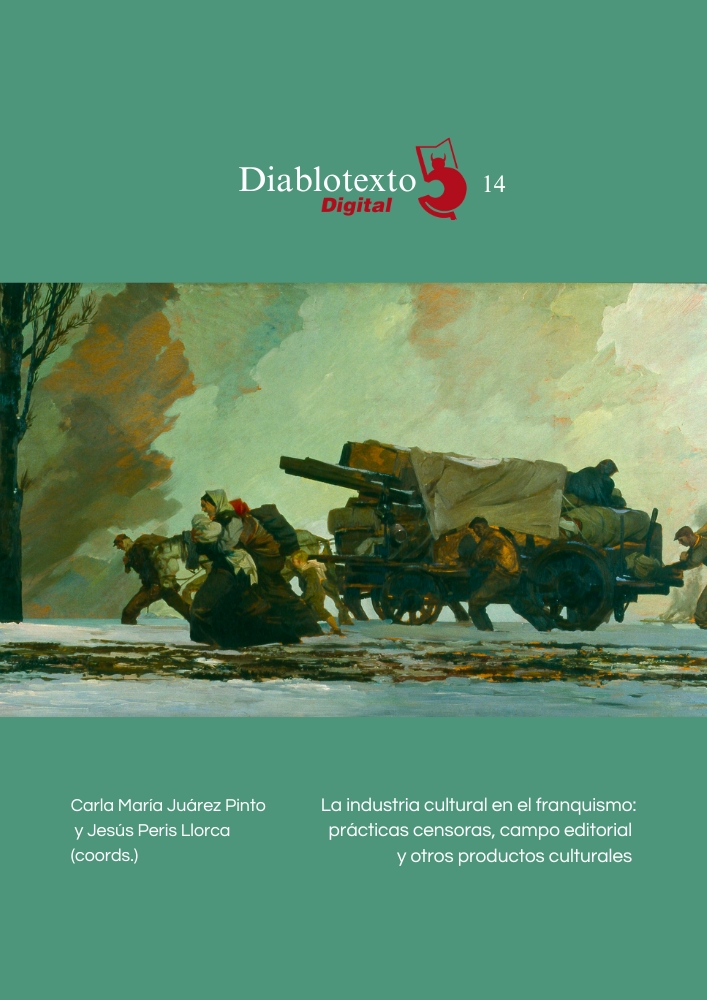Spaces of Dissent: Translation, Circulation, and Censorship of Henry Miller’s and Anaïs Nin’s Works in Late-Francoism
DOI:
https://doi.org/10.7203/diablotexto.14.25867Keywords:
censorship, translation, importation of books, Late-Francoism, archive Abstract
Abstract
This article showcases the importation and circulation of translations in Late-Francoism, focusing on the reception of Henry Miller’s and Anaïs Nin’s novels by studying import and censorship files at Archivo General de la Administración. It analyzes the textual processes that different translations underwent by means of correspondence between agents involved in producing such translations in Spanish and Catalan. This article sheds light on transnational editorial relationships that existed during the Franco regime when importing foreign literature, especially works already translated into Spanish in other parts of the Spanish-speaking world in contrast to those published in the Peninsula.
 Downloads
Downloads
 References
References
Abellán, Manuel Luis (1980). Censura y creación literaria en España (1939-1976). Barcelona: Península.
Andrés, Gabriel (2012). La batalla del libro en el primer franquismo: política del libro, censura y traducciones italianas. Madrid: Huerga & Fierro.
Cisquella, Georgina, et al. (2002). La represión cultural en el franquismo: diez años de censura de libros durante la Ley de Prensa (1966-1976). Barcelona: Anagrama.
Cornellà-Detrell, Jordi (2019). “Franco’s Invisible Legacy: Books across the Hispanic World Are Still Scarred by His Censorship”, The Conversation, s.p. Disponible en https://theconversation.com/francos-invisible-legacy-books-across-the-hispanic-world-are-still-scarred-by-his-censorship-115488 [Fecha de consulta: 15 de diciembre de 2022]
Cornellà-Detrell, Jordi (2016). “El terratrèmol de les lletres catalanes: Traducció, censura i mercat del llibre en català als anys 60.” En Laura Vilardell (ed.), Traducció i censura en el franquisme. Barcelona: Publicacions de l’Abadia de Montserrat, pp. 97-126.
Delgado, Luisa Elena (2016). “Public Tears and Secrets of the Heart. Political Emotions in a State of Crisis”. En Luisa Elena Delgado, Pura Fernández, Jo Labanyi (ed.), Engaging the Emotions in Spanish Culture and History. Nashville: Vanderbilt UP, pp. 262-282.
Godayol, Pilar (2019). “Depicting Censorship Under Franco’s Dictatorship: Mary McCarthy, a Controversial Figure”. En Lucía Pintado Gutiérrez y A. Castillo Villanueva (eds.), New Approaches to Translation, Conflict and Memory. New York: Palgrave Studies, pp. 91-111.
Gómez, Cristina (2009). “Censorship in Francoist Spain and the Importation of Translations from South America: The Case of Lawrence Durrell’s Justine”. Translation and Censorship: Patterns of Communication and Interference. Dublín: Four Courts Press, pp.132-46.
Jané-Lligé, Jordi (2016). “La traducción de narrativa dels anys 60 i la censura”. En Laura Vilardell (ed.), Traducció i censura en el franquisme. Barcelona: Publicacions de l’Abadia de Montserrat, pp. 75-96.
Lago Carballo, Antonio et al. (2006). Un viaje de ida y vuelta. La edición española e iberoamericana (1936-1975). Madrid: Siruela.
Larraz, Fernando (2014). Letricidio español. Censura y novela durante el franquismo. Gijón: Trea.
Lefevere, André (1992). Translation, rewriting & the manipulation of literary fame. Londres: Routledge.
Massot i Muntaner, Josep (2016). “Pròleg”. En Laura Vilardell (ed.), Traducció i censura en el franquisme. Barcelona: Publicacions de l’Abadia de Montserrat, pp. 5-8.
Monzón, Sofía (2022). “Censores, traductores y editoriales transatlánticas: la circulación de Primavera negra de Henry Miller en España (1960-1980)”, Entreculturas revista de traducción y comunicación intercultural, n.º 12, pp. 101-11.
Monzón, Sofía (2020). “The struggles of translating Henry Miller in Franco’s Spain (1939-1975): the different versions of Black Spring (1936)”, Transletters. International Journal of Translation and Interpreting, vol. 4, pp. 203-19.
Neuschäfter, Hans-Jörg (1994). Adiós a la España eterna. La dialéctica de la censura. Novela, teatro y cine bajo el franquismo. Trad. Rosa Pilar Blanco. Barcelona: Anthropos.
Petersen, Lucas (2019). “Santiago Rueda un editor insólito”, Noticias, s.p. Disponible en https://noticias.perfil.com/noticias/cultura/2019-08-13-santiago-rueda-un-editor-insolito.phtml [Fecha de consulta: 15 de diciembre de 2022].
Rojas Claros, Francisco (2013). Dirigismo cultural y disidencia editorial en España (1962–1973). Alicante: Publicaciones de la U de Alicante, s.p.
Ruiz Bautista, Eduardo (2008). Tiempo de censura: la represión editorial durante el franquismo. Gijón: Trea.
Sánchez Zapatero, Javier (2012). “La recepción de la narrativa del exilio republicano español: memoria, distorsión y olvido.” En Georges Tyras, Juan Vila (ed.), Memoria y testimonio: representaciones memorísticas en la España contemporánea. Madrid: Verbum, pp. 75-91.
Downloads
Published
How to Cite
-
Abstract218
-
PDF (Español)104
Issue
Section
License
Licencia de reconocimiento de Creative Commons “Reconocimiento - No Comercia l- Sin Obra Derivada
Authors who publish with this journal agree to the following items:
The authors will keep their copyright and guarantee the journal the right of first publication of their work, which will be simultaneously subject to the Creative Commons license that allows third parties to share the work indicating its author and its first publication in the journal. The authors may adopt other non-exclusive license agreements to distribute the version of the published work (e.g., depositing it in an institutional telematic file or publishing it in a monographic volume), with an acknowledgment of its initial publication in this journal. The authors are allowed and encouraged to disseminate their work through the Internet (e.g., in institutional telematic archives or on their website) before and during the submission process, which can produce interesting exchanges and increase citations of the published work. (See Effect of Open Access)




